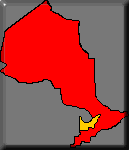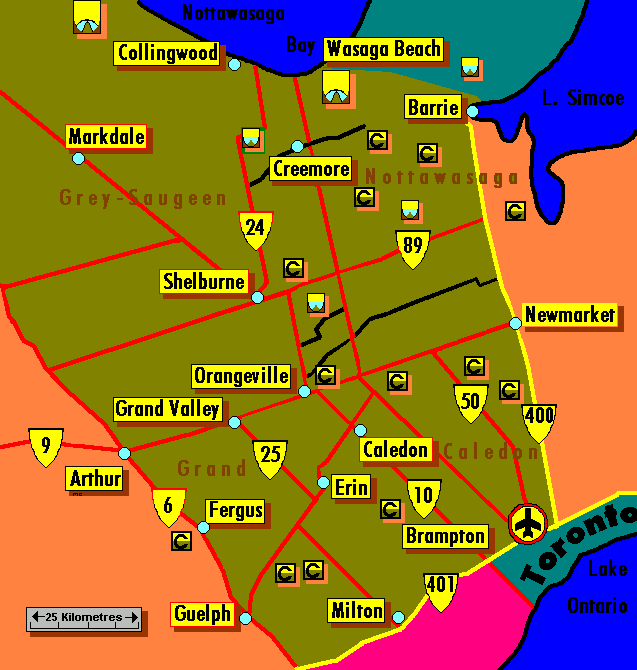
 |
||||
|
 |
|

|

|
Region 3: LakeLandsThe thumbnails show the location of the region within the province. Clicking on it raises you to the level shown. |
This has become the common name associated with the district centred upon Orangeville some 80 kilometres northwest of Toronto. The Niagara escarpment stretches like a spine through this area, splitting the rivers apart. It is from this centre that the flow of the rivers separate; heading in all directions. This area overlaps tourism areas one, two and three and so is accessible from all these regions. For the purpose of navigating this site it will be treated as a district of Region 3
Highways ten and 24 parallel the escarpment, mimicing the natural landscapes north-south axis. Highway nine neatly bisects this zone east-west. There is a noticeable change in the human presence north of highway nine. The watershed is approximately in Orangeville's location. The headwaters district divides into four areas.
|
|
|
|
|
| Nottawasaga | North East Quadrant of Highway 9 and10 | Dufferin and Simcoe | Creemore |
| Caledon | South East of 10 and 9, Credit and Humber Valleys | Peel and York | Caledon |
| Grand | South West of 10 and 9 | Wellington, Halton, Dufferin and Peel | Elora |
| Grey-Saugeen | North-West of 10 and 9 | Dufferin, Grey and Wellington | Shelburne |

Area Maps
|
The backbone of this zone is the Niagara Escarpment which plows its way northwards leaving a wake of hills and cliffs, valleys and rushing rivers. The Bruce Trail meanders through this beautiful landscape providing year-round pleasure for thousands. The waters have provided everything from electric power, to transport, to the basic ingredient in the beer of a host of micro-breweries. Swimming and fishing holes abound. The rolling hills make for enjoyable drives and arduous bike rides, both on and off road.
Outdoor activities can reach the racous exuberance of places like Wasaga Beach and Collingwood, to the serene whispers of isolated vallies and streams.
Small town with some interesting architecture, several shops and restaurants.
Named after Commodore Robert Barrie, this town was settled in the 1830's. Its location on Kempenfelt Bay makes it an important destination for watersports. The town of 40,000 has a diverse manufacturing base and its linked to Toronto with a 400 series highway.
A town of almost two hundred thousand its has sprung from the humble roots of Buffy's Corners, a hamlet founded in 1830. Numerous restaurants, shops, and markets offer plenty of activities.
Located at near the upper reaches of the Credit and Humber river, Caledon is an important crossroads. Recently it has achieved new fame as the name of "Caledon Hockley" the villain of the film Titanic. This name reflects the directors childhood in this area. In addition to the landscape the small town hosts a collection of craft and antique shops.
Named after Admiral Collingwood, Lord Nelson's second in command at the Battle of Trafalgar, this town was an important shipbuilding centre. It is now best known for its winter skiing conditions. Blue Mountain, the no-pun-intended-pinnacle of this activity towers up over the surrounding landscape offering a spectacular view of Georgian Bay. The limestone rock found here is the same as that along the Bruce Peninsula, the resulting erosion has created caves, several that operate as scenic tourist destinations.
The town boasts the smallest jail in Ontario. The welcome rise of micro-breweries in Ontario during the last decade has seen Creemore's fortune as a major centre of the "Ale Trail" also grow. The wells of this town providing the primary ingredient in the beer.
This small town located between Guelph and Orangeville is lovingly maintained. The main street is lit with recreated iron lampposts. Dozens of old shops, bakeries and restaurants make it a popular summer walk-and-shop destination.
These two towns poised on the edge of Elora Gorge offer the breathtaking spectacle of the natural landscape itself, and the beautifully maintained human landscape of a Victorian town. Fergus is also well known for its annual Highland games.
This town of 2000 along the banks of the river has a few shops and restaurants. A small conservation site preserves an admirable stretch of the river bank for all to enjoy. It provides a serene spot for a picnic. The town has grown slowly and has avoided the scourge of many old towns of surrounding the original core in a bland modern housing subdivision.
This university town preserves a great deal of its 19-century architecture. It was founded in 1827 by novelist John Galt and was unusual in that it was a planned community. The original design was that of a radial design similar to the spoked-wheel arrangement of many older European cities. Some of this original design is still evident as one travels across the city. This radial pattern is found very infrequently in Canadian towns. For more info, see the
City of Guelph website.This small town sports several stores and restaurants.
Perched on the edge of both the 401 and the Niagara Escarpment this is a town of contrasts. A modern highway roars along the valley, and minutes away is the quite splendour of the rugged spine of Ontario. The Bruce trail, and scenic roads pass through this town. RattleSnake Point Conservation Area, and an Agricultural museum are some of the attractions here. Of interesting historic note the Robertson head or square head screwdriver was invented here. It is one of the most effective screwdrivers, yet is virtually unknown outside of Canada.
Formed, as its name suggests as a new market for the surrounding communities, this town preserves buildings as far back as 1810. The ruins of a canal system can be found within the town.
Named after Orange Lawrence who ran a mill at the towns location this well preserved town is nestled among the Caledon Hills. The Niagara Escarpment winds through the area providing rolling vistas, cliffs, and rushing rivers. The town features several restaurants, and several resorts nearby.
Town WebsiteA growing community Shelburne preserves its past in a well maintained downtown core. The surrounding countryside offers plenty of parks and conservation areas for outdoor activities.
A popular summer playground, the arcing beach offers miles of shoreline to play on. The town offers lots of shops, restaurants, music and water slides. Further down the beach quieter areas can be found. Conservation areas nearby serve as popular cross-country skiing spots in winter. The water is warmer here than usual for Georgian Bay.
SITE INDEX:
[MAIN MENU] [MAP INDEX] [American Visitors] [World Wide Visitors] [Canadian Visitors] [Help] [Advertise Here]© M. Colautti 1998, 1999, 2000</>
Visit the new national site CanExplore